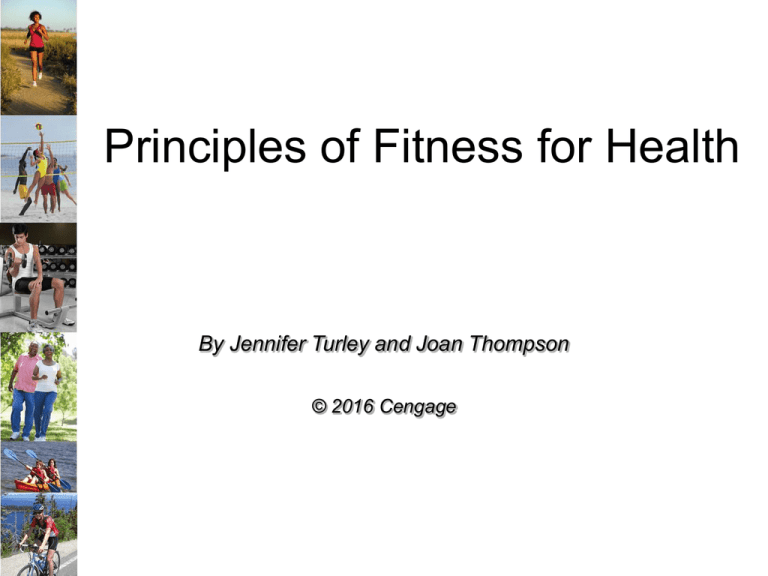Principles of Fitness for Health By Jennifer Turley and Joan Thompson
advertisement

Principles of Fitness for Health By Jennifer Turley and Joan Thompson © 2016 Cengage Presentation Overview • • • • • Total Fitness For Health Fitness Testing Aerobic and Resistive Exercise The Overload Principle Logging Activity for Weight Control and Health Total Fitness for Health • “Fitness is health!” • It has been document that individuals who are physical fit have far less mortality and morbidity as compared to their sedentary counterparts. • What does being physically fit mean? • What are the health benefits of exercise? The Values of Exercise Exercise Value Specific areas of benefit General Health Improved mental health Increased feeling of vigor Improved sleep pattern Increased bone density Decreased risk of chronic diseases such as cancer, heart disease, diabetes, arthritis, and vascular diseases Body Composition and Weight Control Decreased percent body fat Increased lean body mass Stabilized body weight Increased metabolic rate Improved muscle tone Cardio-Respiratory Health and Fitness Improved circulation (pumping capacity of the heart, stroke volume, oxygen delivery capacity to the tissues, and promotion of wound healing, decreased tendency for infections) Increased oxygen uptake Improved lipid profile, decreased total cholesterol (increased HDL, decreased LDL), decreased triglycerides Decreased blood pressure Decreased heart rate Increased efficiency of metabolic processes (fat metabolism and carbohydrate metabolism) Athletic Performance Improve competitiveness in sporting events Body Sculpting Fitness Testing • The accumulated score from the elements of evaluating: – Aerobic capacity – Muscular strength – Muscular endurance – Flexibility – Body composition • A high overall score is associated with health and longevity Developing a Total Fitness Program • A safe and effective fitness program to perform well in Physical Fitness testing and reduce the risk of injury includes a: – Warm-up – Aerobic exercise – Resistive exercise – Flexibility exercise – Cool-down Aerobic & Resistive Exercise • Aerobic exercise demands a higher functioning level of the cardiorespiratory systems – The capacity is reflected by VO2max • Resistive exercise demands a higher functioning level of the skeletalmuscular systems – The capacities are displayed through measures of muscular strength and muscular endurance Aerobic Exercise • Physical activity where the heart rate can be elevated and maintained steadily for at least ten minutes and there is increased oxygen uptake and delivery to the body and muscles • A few examples include walking, jogging, cycling, swimming, and cross country skiing • The three parameters that affect aerobic capacity are frequency, intensity and duration of the exercise Heart rate, exercise intensity, and physiological responses The FIT Classification System, Part 1 • You can use: – F-frequency (times per week) – I- intensity (percent of maximum heart rate, %MHR) – T-time (the number of minutes that the elevated heart rate is maintained • To classify your level of cardiovascular competency by the following table: The FIT Classification System, Part 2 Factor F - frequency (days/wk) I - intensity (%MHR) T - time (continuous minutes) Low 3 Average 4 High 5+ 60 – 69 (low) 70 – 79 (moderat e) 15-45 80-90 (high) 10 - 20 30-60 Resistive Exercise • One can improve muscular strength or muscular endurance by determining first, the one-repetition maximum and then adjusting the amount of: – Resistance (the amount of opposing weight during the muscle contraction, strength train at 80% of the onerep-max) – The number of repetitions of the muscular contraction and the number of sets completed – Speed of the muscle contraction • 3-4 sets of 8-12 reps twice a week to maintain strength and three times a week to gain strength. • There are many ways to contract a muscle and affect muscle strength Muscle Contractions, Training Types, and Balanced Lifts Muscle Contractions Eccentric Muscle Contraction Muscle is elongating while contracting or generating tension Concentric Muscle Contraction Muscle is shortening while contracting or generating tension Isometric Muscle Contraction Static muscle length while muscle generates tension. This type of contraction is uses when joints are injured to attempt to maintain some muscle strength. Training Types Isometric Training Program involves a series of isometric muscle contractions. Isokinetic Training The use of special equipment to control the speed of the muscle contractions. Circuit Training Combines aerobic activity with resistive activity for the purposes of increasing calorie burn, reducing boredom and improving fitness. Weight Training Program involves lifting weights. Balance Lifts Bench press/seated row Dumbbell bench press/ bent-over row Shoulder press/lateral pulls Seated leg press/truck flex Pectoral fly/bent-over fly Upright row/dips Lateral raises/medial pulls Leg extension/leg curls Bicep curl/tricep extension The Overload Principle • The Overload Principle involves applying a greater work load than normal on the cardio-respiratory or skeletal-muscular systems that leads to increased functional capacity • For aerobic capacity improvement, one must work at least at 70%MHR • For muscular strength, one must lift at least at 80% of the 1-rep-max (3 sets of 8-12 reps) Logging Activity for Weight Control and Health • An exercise volume that has been associated with reducing the risk of chronic disease is burning between 2,000-3,000 Calories per week in exercise • 30-45 minutes of moderate intensity exercise, 3-5 times per week promotes weight loss. • 60 minutes of rigorous activity per day is needed to lose weight, keep the weight off, and improve functional capacity. Logging Activity for Health • You can use the following activity log to evaluate your exercise for; • Total fitness format – – – – – Warm-up Aerobic exercise Resistive exercise Flexibility exercise Cool-down • Calorie burn of activities – Time x factor x REE ÷ 24 Exercise Activity Log Some Summary Points, Part 1 • The common dominator for exercise is Calorie burn and a minimum amount of exercise to yield health benefits is burning between 2,000 and 3,000 Calories per week. • To lose weight, to keep the weight off, and to improve functional capacity 60 minutes of rigorous activity is needed daily. • The parameters evaluated in physical fitness testing include; body composition, flexibility, aerobic capacity, muscular strength, and muscular endurance. Some Summary Points, Part 2 • A total fitness program can support a good rating on physical fitness testing because it includes; a warm-up, cool-down, flexibility exercises, aerobic activities, and resistive muscular work. • The three parameters to increase for improving aerobic capacity are frequency, intensity and time. • The three parameters to increase for improving muscular strength are the amount of resistance, the number of reps and sets, and the speed of the muscle contractions. References for this presentation are the same as those for this topic found in module 4 of the textbook


